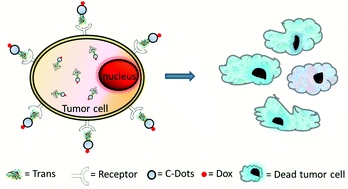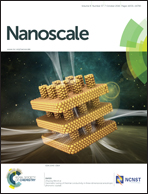Transferrin conjugated nontoxic carbon dots for doxorubicin delivery to target pediatric brain tumor cells†
Abstract
Among various cancers, pediatric brain tumors represent the most common cancer type in children and the second most common cause of cancer related deaths. Anticancer drugs and therapies, such as doxorubicin (Dox), have severe side effects on patients during chemotherapy, especially for children as their bodies are still under development. These side effects are believed to be due to the lack of a delivery system with high efficacy and targeting selectivity, resulting in serious damages of normal cells. To improve the efficacy and selectivity, the transferrin (Trans) receptor mediated endocytosis can be utilized for drug delivery system design, as transferrin receptors are expressed on the blood brain barrier (BBB) and often over expressed in brain tumor cells. Carbon dots (C-Dots) have recently emerged as benign nanoparticles in biomedical applications owing to their good water solubility, tunable surface functionalities and excellent biocompatibility. The unique characteristics of C-Dots make them promising candidates for drug delivery development. In this study, carbon dots–transferrin–doxorubicin covalent conjugate (C-Dots–Trans–Dox) was synthesized, characterized by different spectroscopic techniques and investigated for the potential application as a drug delivery system for anticancer drug doxorubicin to treat pediatric brain tumors. Our in vitro results demonstrate greater uptake of the C-Dots–Trans–Dox conjugate compared to Dox alone presumably owing to the high levels of transferrin receptors on these tumor cells. Experiment showed that C-Dots–Trans–Dox at 10 nM was significantly more cytotoxic than Dox alone, reducing viability by 14–45%, across multiple pediatric brain tumor cell lines.


 Please wait while we load your content...
Please wait while we load your content...